
Physalaemus nattereri is a frog native to central and southeastern Brazil and eastern Bolivia and Paraguay.

The powdered glass frog or Chiriqui glass frog is a frog species in the glass frog family (Centrolenidae). The species is found from north-central Honduras south to northwestern Ecuador.

Callimedusa atelopoides is a species of frog in the subfamily Phyllomedusinae. It is known from Amazonian Bolivia, Brazil, and Peru, and is likely to be found in adjacent Colombia and Ecuador. Common name toady leaf frog has been proposed for it.

Callimedusa ecuatoriana is a species of frog in the subfamily Phyllomedusinae. It is endemic to Ecuador and known from the Amazonian slopes of the Andes in the Morona-Santiago Province as well as from Cordillera del Condor in the Zamora-Chinchipe Province. Common name Agua Rica leaf frog has been proposed for it.
Scinax chiquitanus is a species of frog in the family Hylidae. It is known from Amazonian Bolivia and from Department of Madre de Dios in Peru. The Peruvian populations might represent a distinct species.
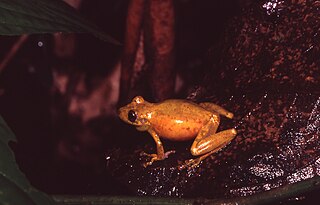
Scinax cruentomma is a species of frog in the family Hylidae. It is found in the upper Amazon Basin of southern Colombia, eastern Ecuador, northeastern and east-central Peru, and western Brazil; its presence is French Guiana is dispted. The specific name cruentomma is derived from the Greek cruentos meaning "bloody" and omma meaning "eye", referring to the red streak in the eye of this frog. This species is also known as the Manaus snouted treefrog.
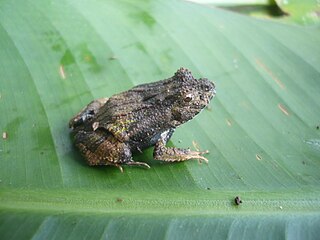
Edalorhina perezi is a species of frog in the family Leptodactylidae. It is one of the only two species in the genus Edalorhina in the family Leptodactylidae. This species is diurnal and terrestrial. During mating season both female and male frogs gather around treefall pools. It is found in Brazil, Colombia, Ecuador, and Peru, and possibly Bolivia. Its natural habitats are subtropical or tropical moist lowland forests, subtropical or tropical moist montane forests, and freshwater marshes. The species listed as least concern on the IUCN Red List and the population is stable.
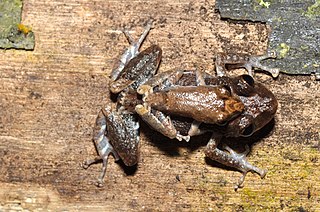
Pristimantis altamazonicus is a species of frog in the family Strabomantidae. As currently defined, it is known from the Amazon rainforest of Colombia, Ecuador, and Peru.
Psychrophrynella bagrecito is a species of frog in the family Strabomantidae. It is endemic to the Cusco Region, Peru, and found on the Amazonian slopes of the Andes at elevations of 1,830–2,740 m (6,000–8,990 ft) asl. The specific name bagrecito is Spanish meaning a small catfish, and a nickname for David C. Cannatella, a colleague of John D. Lynch, the scientist who described the species from specimens collected from near Marcapata.
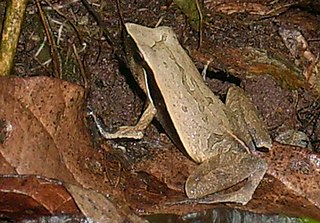
Physalaemus albonotatus is a species of frog in the family Leptodactylidae. It is found in Brazil, Paraguay, and Chacoan Argentina and Bolivia.
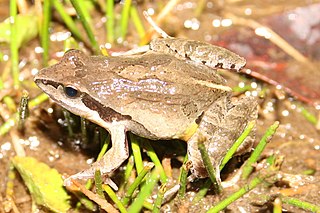
Physalaemus barrioi is a species of frog in the family Leptodactylidae. It is endemic to Serra do Bocaina in São Paulo state, Brazil. The specific name barrioi honors Avelino Barrio, a Spanish botanist and zoologist who lived in Argentina. However, the common name Bocaina dwarf frog has been proposed for it.

Engystomops coloradorum, also known as Colorado dwarf frog, is a species of frogs in the family Leptodactylidae. It is endemic to the Pacific lowlands and foothills of the Andes in the Pichincha and Santo Domingo de los Tsáchilas Provinces, Ecuador.
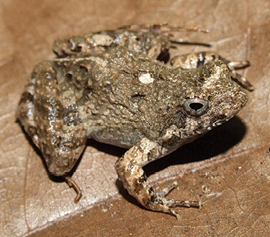
Physalaemus erikae is a species of frog in the family Leptodactylidae. It is endemic to eastern Brazil and currently known only from southern Bahia, although it is likely that its range extends into nearby areas in northeastern Minas Gerais and northern Espírito Santo with similar vegetation.
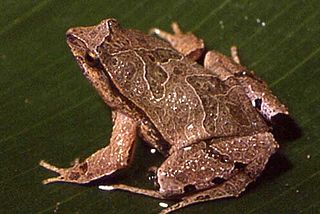
Physalaemus maculiventris is a species of frog in the family Leptodactylidae. It is endemic to Southeast and South Brazil and is known primarily from the Serra do Mar in Espírito Santo, Rio de Janeiro, São Paulo state, Paraná, and Santa Catarina states. Common name Mantagnes dwarf frog has been proposed for it.
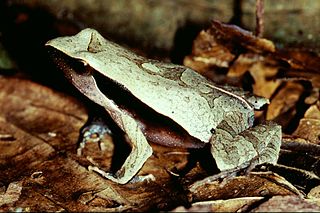
Physalaemus olfersii is a species of frog in the family Leptodactylidae. It is endemic to southeastern Brazil and is known from Espírito Santo, southeastern Minas Gerais, and São Paulo states. Records further south refer to Physalaemus lateristriga, which was restored from the synonymy of Physalaemus olfersii in 2010. Common name Atlantic Forest dwarf frog has been proposed for this species.

Engystomops petersi is a species of frog in the family Leptodactylidae. It is found in Amazonian Colombia, Ecuador, and Peru. It is morphologically similar to its sibling species, Engystomops freibergi, and for a period the latter was considered to be a junior synonym of Engystomops petersi. Taxonomy and classification of this species is constantly changing due to the continual evolution of behavioral isolation and rapid speciation in the region. There are also records from the Guianas that have not yet been allocated to either species. Divergence of these two species seems to have been driven by behavioural isolation related to male call characteristics more than geographic isolation.
Engystomops pustulatus is a species of frog in the family Leptodactylidae. It is known with certainty from western Ecuador, whereas the status of Peruvian records is ambiguous as they may refer to an undescribed species or possibly Engystomops puyango. Nevertheless, given that E. pustulatus is now known from Huaquillas in southern Ecuador, near the Peruvian border, it is likely to be found in Peru too.

The Túngara frog is a species of frog in the family Leptodactylidae. It is a small nocturnal terrestrial frog found in Mexico, Central America, and the northeastern regions of South America.
Oreobates ayacucho is a species of frogs in the family Strabomantidae. It is endemic to Peru and known from a few localities in the Ayacucho Region in the Peruvian Andes. The species is only known from 11 specimens.

Engystomops is a genus of frogs in the family Leptodactylidae. They are known commonly as foam frogs or túngara frogs, though the latter name most commonly refers to Engystomops pustulosus. They are native to the Americas from southern Mexico south to the Amazon Basin.















